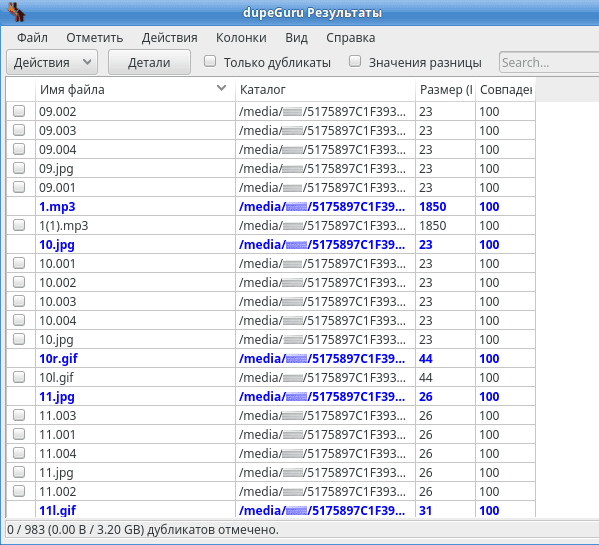

- #Dupeguru ubuntu command line drivers#
- #Dupeguru ubuntu command line manual#
- #Dupeguru ubuntu command line full#
- #Dupeguru ubuntu command line windows 10#
- #Dupeguru ubuntu command line Pc#
A form of basic masks is also embeded into extracted faces by default which is derived from facial landmarks, it's a basic mask that can be used to do basic swaps using Full Face face type models or lower (more about face types and masks later in the guide) Masks - generated by XSeg model, masks are needed to define areas of the face that are supposed to be trained (be it SRC or DST faces) as well as define shape and obstructions needed for final masking during merging (DST). XSeg labels - labels created by user in the XSeg editor that define shapes of faces, may also include exclusions (or not include in the first place) obstructions over SRC and DST faces, used to train XSeg model to generate masks. XSeg - User trainable masking model used to generate more precise masks for SRC and DST faces that can exlcude various obstructions (depending on users labels on SRC and DST faces), DFL comes with generic trained Whole Face masking model you can use if you don't want to create your own labels right away. Quick 96 - Testing model, uses SAEHD DF-UD 96 resolution parameters and Full Face face type, meant for quick tests.Ĥ. Unlike SAEHD doesn't have different architectures to choose from and is less versatile when it comes to reusal and takes much longer to train, also doesn't have pretrain option but can offer much higher quality and results can look more like SRC.ģ.
#Dupeguru ubuntu command line manual#
AMP - new experimental model that can adapt more to the source data and retain it's shape, meaning you can use it to swap faces that look nothing alike however this requires manual compositing as DFL does not have more advanced masking techniques such as background inpainting. Can be freely reused, pretrained and in general can offer quick results at decent quality but some architectures can suffer from low likeness or poor lighting and color matching.Ģ. SAEHD - most popular and most often used model, comes in several different variants based on various architectures, each with it's own advantages and disadvantages however in general it's meant to swap faces when both SRC and DST share some similarities, particularly general face/head shape. Model - collection of files that make up SAEHD, AMP and XSeg models that user can create/train, all are placed inside the "model" folder which is inside the "workspace" folder, basic description models below (more detailed later in the guide):ġ. SRC set/SRC dataset/Source dataset/SRC faces - extracted faces (square ratio image file of the source face that contains additional data like landmarks, masks, xseg labels, position/size/rotation on original frame) of the person we are trying to swap into a video.ĭST - always refers to content (frames, faces) from the target video (or DST/DST video) we are swapping faces in.ĭST set/DST dataset/Target dataset/DST faces - collection of extracted faces of the target person whose faces we will be replacing with likeness of SRC, same format and contains the same type of data as SRC faces.įrames - frames extracted from either source or target videos, after extraction of frames they're placed inside "data_src" or "data_dst" folders respectively.įaces - SRC/DST images of faces extracted from original frames derived from videos or photos used. SRC - always refers to content (frames, faces) of the person whose face we are trying to swap into a target video or photo.

workspace - this is where your models, videos, frames, datasets and final video outputs are._internal - internal files, stuff that makes DFL work, No Touchy!.bat, these scripts are used to run various processes required to create a deepfakes, in the main folder you'll see them and 2 folders: for modern AMD cards use "DeepFaceLab_DirectX12" build (may not work on some older AMD GPUs). for Nvidia RTX 3000-4000 series cards and other GPUs utilizing the same architectures use "DeepFaceLab_NVIDIA_RTX3000_series" build. for Nvidia GTX 900-1000 and RTX 2000 series and other GPUs utilizing the same architectures as those series use "DeepFaceLab_NVIDIA_up_to_RTX2080Ti" build. Download correct build of DFL for your GPU (build naming scheme may change):
#Dupeguru ubuntu command line drivers#
Make sure to enable Hardware-Accelerated GPU Scheduling under Windows 10/11 and ensure your gpu drivers are up-to-date.Ģ. plenty of storage space and large pagefile modern Nvidia or AMD GPU with 8GB of VRAM modern 4 core CPU supporting AVX and SSE instructions Minimum requirements for making very basic and low quality/resolution deepfakes:
#Dupeguru ubuntu command line windows 10#
Windows 10 is generally recommended for most users but more advanced users may want to use Linux to get better performance.

#Dupeguru ubuntu command line Pc#
Usage of Deep Face Lab 2.0 requires high performance PC with modern GPU, ample RAM, storage and fast CPU.


 0 kommentar(er)
0 kommentar(er)
